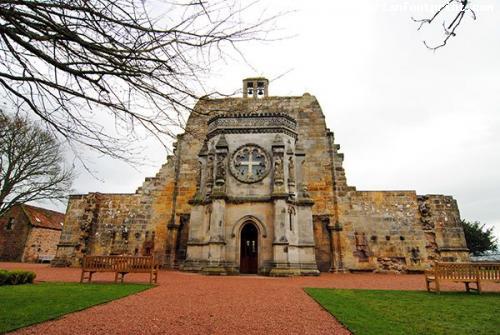You seem to be using an older version of Internet Explorer. This site requires Internet Explorer 8 or higher. Update your browser here today to fully enjoy all the marvels of this site.
March 22, 2018 by Alexander Meldrum
Rosslyn Chapel,
formally known as the Collegiate Chapel of St Matthew, is a 15th-century chapel located in the village of Roslin, Midlothian, Scotland.
Rosslyn Chapel was founded on a small hill ab...Rosslyn Chapel,
formally known as the Collegiate Chapel of St Matthew, is a 15th-century chapel located in the village of Roslin, Midlothian, Scotland.
Rosslyn Chapel was founded on a small hill above Roslin Glen as a Catholic collegiate church (with between four and six ordained canons and two boy choristers) in the mid-15th century.
The chapel was founded by William Sinclair, 1st Earl of Caithness of the Scoto-Norman Sinclair family. Rosslyn Chapel is the third Sinclair place of worship at Roslin,
the first being in Roslin Castle and the second (whose crumbling buttresses can still be seen today) in what is now Roslin Cemetery.
Sinclair founded the college to celebrate the Divine Office throughout the day and night, and also to celebrate Masses for all the faithful departed, including the deceased members of the Sinclair family.
During this period, the rich heritage of plainsong (a single melodic line) or polyphony (vocal harmony) were used to enrich the singing of the liturgy.
Sinclair provided an endowment to pay for the support of the priests and choristers in perpetuity. The priests also had parochial responsibilities.
After the Scottish Reformation (1560), Roman Catholic worship in the chapel was brought to an end. The Sinclair family continued to be Roman Catholics until the early 18th century.
From that time, the chapel was closed to public worship until 1861. It was re-opened as a place of worship according to the rites of the Scottish Episcopal Church, a member church of the Anglican Communion.
One of the more notable architectural features of the Chapel is the "Apprentice Pillar, or "Prentice Pillar". Originally called the "Prince's Pillar" (in the 1778 document An Account of the Chapel of Roslin)
The name morphed over time due to a legend dating from the 18th century, involving the master mason in charge of the stonework in the chapel and his young apprentice mason.
According to the legend, the master mason did not believe that the apprentice could perform the complicated task of carving the column without seeing the original which formed the inspiration for the design.
The master mason travelled to see the original himself, but upon his return was enraged to find that the upstart apprentice had completed the column by himself.
In a fit of jealous anger, the master mason took his mallet and struck the apprentice on the head, killing him. The legend concludes that as punishment for his crime,
The master mason's face was carved into the opposite corner to forever gaze upon his apprentice's pillar.
On the architrave joining the pillar there is an inscription, Forte est vinum fortior est rex fortiores sunt mulieres super omnia vincit veritas: "Wine is strong, a king is stronger, women are stronger still, but truth conquers all"
The Crypt
The chapel has been a burial place for several generations of the Sinclairs; a crypt was once accessible from a descending stair at the rear of the chapel.
This crypt has been sealed shut for many years, which may explain the recurrent legends that it is merely a front to a more extensive subterranean vault containing (variously)
the mummified head of Jesus Christ,the Holy Grail,[18] the treasure of the Templars, or the original crown jewels of Scotland.
In 1837, when the 2nd Earl of Rosslyn died, his wish was to be buried in the original vault. Exhaustive searches over the period of a week were made,
but no entrance to the original vault was found and he was buried beside his wife in the Lady Chapel.
In this photo:


